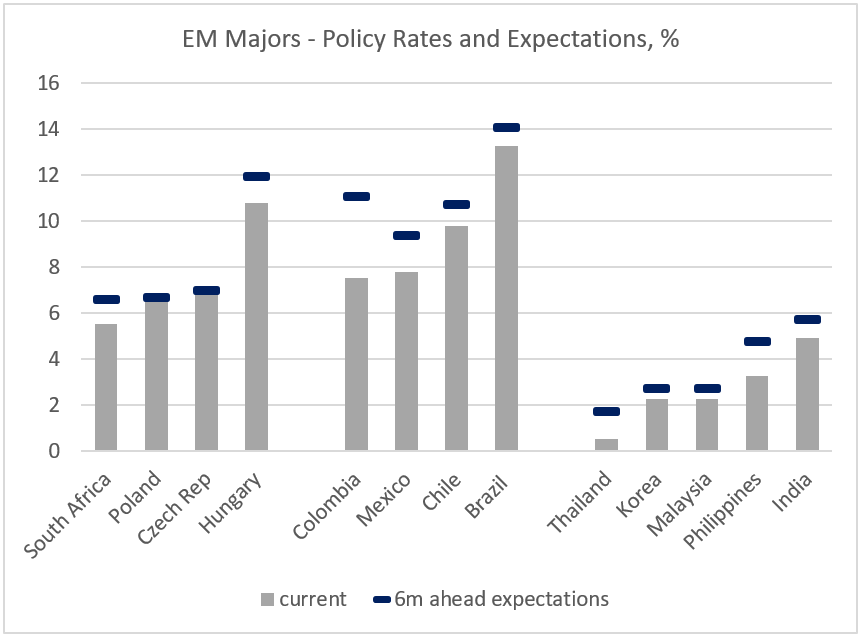tum3123
Are EM rates peaking sooner and lower than expected? We keep an eye on inflation/growth patterns, and also on the amount of the past rate hike frontloading.
EM Rate Expectations
The peak rates chatter refuses to go away – and there are good reasons for that. First, emerging markets’ (EM) central banks frontloaded a lot of rate hikes, and real policy rates adjusted by expected inflation are now very positive (maybe even contractionary) in quite a few EMs. The recent “super-sized” and off-cycle rate hikes helped to cement this perception, and the market (mostly swap curves) now see no additional tightening in most of Central Europe (Poland, Czech Republic) and relatively small hikes in parts of EM Asia (South Korea, Malaysia – see chart below). Colombia’s expected 150bps rate hike this afternoon will narrow the largest gap between the actual and the expected policy rate among major EMs. And Brazil’s +50bps move in early August will bring it one step closer to the end of the tightening cycle.
Inflation Peaks
The second point is that even though inflation is still extremely high across EM – especially in EMEA and LATAM – it might finally be peaking in some countries. Brazil’s mid-month inflation definitely fits that definition. Poland’s annual headline inflation was unchanged in July (at 15.5%, but a small downside surprise nevertheless). Some commentators pointed out that the sequential momentum in Poland’s core inflation appears to be easing, and that the central bank might use these developments to keep the policy rate on hold in September – which would be a mistake, in our opinion, as the real policy rate is way too negative (however you measure it).
EM Growth Headwinds
Finally, there are lingering concerns about an H2 growth “cliff” in parts of EM. The latest growth/activity prints in some EM were above consensus – including today’s Q2 GDP releases in the Czech Republic and Mexico – but many economists believe that slowdown is already underway in many countries (according to high-frequency indicators), with growth dropping below potential in the coming months. These concerns/observations explain why the next batch of activity surveys (Purchasing Managers Indices, or PMIs) will be closely watched. This would be the first set of PMIs for Q3 – so if we see more “contractionary” PMI prints (<50.0), H2 growth forecasts might be cut even further. Have a great weekend, and stay tuned!
Chart at a Glance: How Much Room Left for Rate Hikes in EM?
Bloomberg LP
————–
PMI – Purchasing Managers’ Index: economic indicators derived from monthly surveys of private sector companies. A reading above 50 indicates expansion, and a reading below 50 indicates contraction; ISM – Institute for Supply Management PMI: ISM releases an index based on more than 400 purchasing and supply managers surveys; both in the manufacturing and non-manufacturing industries; CPI – Consumer Price Index: an index of the variation in prices paid by typical consumers for retail goods and other items; PPI – Producer Price Index: a family of indexes that measures the average change in selling prices received by domestic producers of goods and services over time; PCE inflation – Personal Consumption Expenditures Price Index: one measure of U.S. inflation, tracking the change in prices of goods and services purchased by consumers throughout the economy; MSCI – Morgan Stanley Capital International: an American provider of equity, fixed income, hedge fund stock market indexes, and equity portfolio analysis tools; VIX – CBOE Volatility Index: an index created by the Chicago Board Options Exchange (CBOE), which shows the market’s expectation of 30-day volatility. It is constructed using the implied volatilities on S&P 500 index options.; GBI-EM – JP Morgan’s Government Bond Index – Emerging Markets: comprehensive emerging market debt benchmarks that track local currency bonds issued by Emerging market governments; EMBI – JP Morgan’s Emerging Market Bond Index: JP Morgan’s index of dollar-denominated sovereign bonds issued by a selection of emerging market countries; EMBIG – JP Morgan’s Emerging Market Bond Index Global: tracks total returns for traded external debt instruments in emerging markets.
The information presented does not involve the rendering of personalized investment, financial, legal, or tax advice. This is not an offer to buy or sell, or a solicitation of any offer to buy or sell any of the securities mentioned herein. Certain statements contained herein may constitute projections, forecasts and other forward-looking statements, which do not reflect actual results. Certain information may be provided by third-party sources and, although believed to be reliable, it has not been independently verified and its accuracy or completeness cannot be guaranteed. Any opinions, projections, forecasts, and forward-looking statements presented herein are valid as the date of this communication and are subject to change. The information herein represents the opinion of the author(S), but not necessarily those of VanEck.
Investing in international markets carries risks such as currency fluctuation, regulatory risks, economic and political instability. Emerging markets involve heightened risks related to the same factors as well as increased volatility, lower trading volume, and less liquidity. Emerging markets can have greater custodial and operational risks, and less developed legal and accounting systems than developed markets.
All investing is subject to risk, including the possible loss of the money you invest. As with any investment strategy, there is no guarantee that investment objectives will be met and investors may lose money. Diversification does not ensure a profit or protect against a loss in a declining market. Past performance is no guarantee of future performance.
Editor’s Note: The summary bullets for this article were chosen by Seeking Alpha editors.


Be the first to comment